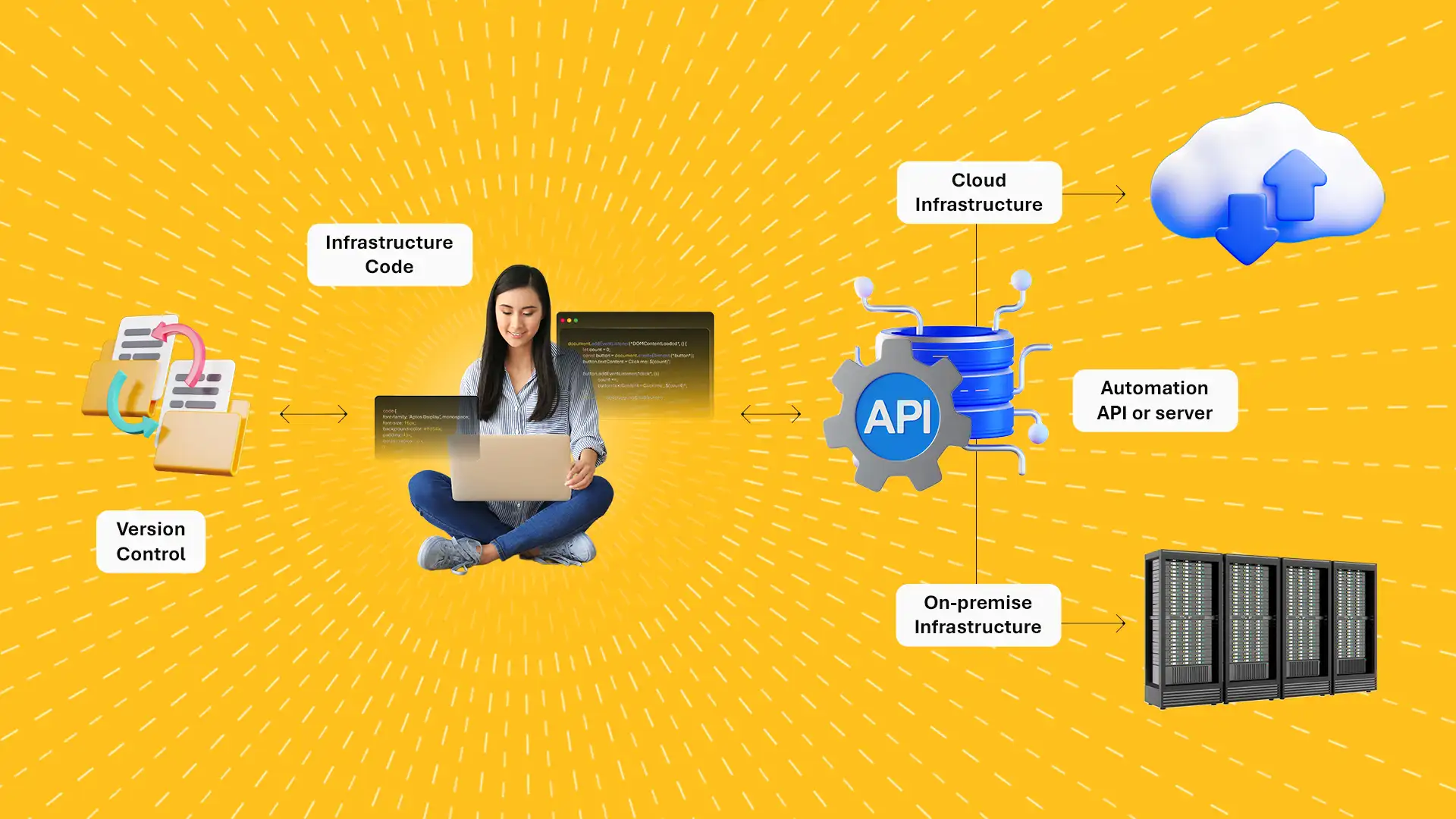Remember the days of manually clicking through consoles to set up servers? Or meticulously following lengthy runbooks, hoping you didn’t miss a step while configuring networks or databases? If you’ve worked in IT or operations, you likely know the pain: slow deployments, inconsistent environments (“it works on my machine!”), configuration drift, and the sheer terror of trying to replicate a complex setup accurately.
Manual infrastructure management is time-consuming, error-prone, and simply doesn’t scale in today’s fast-paced, cloud-centric world. Businesses need to move faster, deploy more reliably, and manage increasingly complex systems without drowning in operational overhead.
This is where Infrastructure as Code (IaC) steps in. It’s not just a buzzword; it’s a fundamental shift in how we approach IT infrastructure, borrowing principles from software development to bring automation, consistency, and speed to the world of servers, networks, databases, load balancers, and more.
But what is IaC, really? Let’s demystify it.
What is Infrastructure as Code (Simply Put)?
At its core, Infrastructure as Code means managing and provisioning your IT infrastructure using definition files – essentially, code – rather than manual processes or interactive configuration tools.
Think of it like this:
- Instead of manually building a house brick by brick, hoping each one is placed correctly, you create a detailed blueprint (your code).
- This blueprint precisely defines every component: the number of servers, their configurations, the network rules, storage requirements, etc.
- You then hand this blueprint to an automated construction crew (IaC tools like Terraform, Ansible, CloudFormation).
- This crew reads the blueprint and builds exactly what’s specified, consistently and repeatedly.
Your infrastructure configuration lives in version-controlled files, just like your application code. This allows you to define, deploy, update, and destroy infrastructure in a predictable, automated, and trackable way.
Why Does IaC Matter? (The Business Value)
Adopting IaC isn’t just about making life easier for IT teams (though it certainly does that). It delivers significant business advantages:
- Speed and Agility: IaC automates provisioning and configuration, drastically reducing the time it takes to deploy new environments or update existing ones. Need a new testing environment identical to production? Run the code. Need to scale up your web servers for a marketing campaign? Update a variable and apply the change. This speed translates directly to faster time-to-market for new features and services.
- Consistency and Reduced Errors: Manual processes are inherently prone to human error. IaC ensures that every environment provisioned from the same code is identical, eliminating configuration drift and the infamous “it works on my machine” problem. This consistency leads to more reliable deployments and fewer environment-specific bugs.
- Reduced Risk: With version control (like Git), every change to your infrastructure code is tracked. You know who changed what, when, and why. If an update causes problems, you can easily roll back to a previous known-good state defined in your code, significantly reducing downtime and mitigating deployment risks.
- Cost Savings: Automation reduces the manual effort required for setup and management, freeing up valuable engineering time for more strategic tasks. Faster deployments, fewer errors, and easier management all contribute to lower operational costs. Furthermore, IaC makes it easier to manage cloud resources effectively, helping to avoid over-provisioning and control cloud spend.
- Enhanced Collaboration & DevOps Enablement: IaC treats infrastructure like application code, fostering better collaboration between development and operations teams (the core of DevOps). Infrastructure definitions can be shared, reviewed, and managed using the same tools and workflows (like pull requests) used for application development.
- Improved Security: Security configurations can be defined and enforced within the IaC code itself. This allows for automated security checks, consistent policy application across all environments, and easier auditing of security settings. Secrets management can also be handled more securely through dedicated IaC features or integrations.
- Scalability: Defining infrastructure in code makes it inherently easier to scale resources up or down based on demand. Modifying configuration files is far simpler and faster than manually adjusting numerous components.
How Does It Work? (The Core Ideas)
While different tools have specific implementations, most IaC approaches rely on a few key concepts:
- Declarative vs. Imperative:
- Declarative (More Common in IaC): You define the desired end state of your infrastructure (e.g., “I need 3 web servers with this configuration, connected to this load balancer”). The IaC tool figures out how to achieve that state. Think of ordering a specific pizza – you state what you want, not the step-by-step instructions for making it. Tools like Terraform and CloudFormation are primarily declarative.
- Imperative: You define the specific sequence of commands to execute to reach the desired state (e.g., “Create server 1, configure server 1, create server 2…”). Think of providing a detailed recipe. Configuration management tools like Ansible can operate imperatively.
- Why it matters: Declarative approaches are generally preferred for provisioning as they simplify state management and make configurations easier to understand.
- Idempotency: This is a crucial concept. An idempotent operation can be applied multiple times without changing the result beyond the initial application. In IaC terms, running your code repeatedly will always result in the same defined infrastructure state. If the infrastructure already matches the code, the tool makes no changes. This ensures predictability and safety – you can re-run your code anytime to enforce the desired state.
- Version Control: Storing your infrastructure code in a version control system like Git is fundamental. This provides:
- History: Track every change made to your infrastructure definitions.
- Collaboration: Teams can work on infrastructure code together using branches and pull requests.
- Rollback: Easily revert to previous working configurations if needed.
- Automation: IaC tools automate the execution of the definition files, interacting with cloud provider APIs (like AWS, Azure, GCP) or other infrastructure components to create, update, or delete resources as defined in the code.
Popular Tools (A Glimpse into the Ecosystem)
The IaC landscape is rich with powerful tools. Some key players include:
- Terraform (HashiCorp): Cloud-agnostic, declarative tool popular for provisioning infrastructure across multiple cloud providers and on-premises environments.
- AWS CloudFormation: AWS-native, declarative service for defining and provisioning AWS resources.
- Azure Resource Manager (ARM) / Bicep: Microsoft Azure’s native declarative solution for provisioning Azure resources (Bicep is a simpler domain-specific language that compiles to ARM templates).
- Google Cloud Deployment Manager: Google Cloud’s native declarative tool for GCP resources.
- Ansible (Red Hat): Often used for configuration management (installing software, configuring services) but can also perform provisioning. Typically uses an imperative approach via “playbooks.”
- Pulumi: Allows defining infrastructure using general-purpose programming languages like Python, Go, TypeScript, etc., offering more flexibility for complex logic.
The choice of tool often depends on your existing ecosystem (cloud provider), team skills, and specific requirements (provisioning vs. configuration management).
Getting Started & Best Practices
Ready to dip your toes in? Here are some tips:
- Start Small: Don’t try to automate everything at once. Pick a specific, well-understood piece of infrastructure (like a simple web server setup or a storage bucket configuration) to start with.
- Use Version Control (Git): This is non-negotiable. Treat your infrastructure code like application code from day one.
- Keep it Modular: Break down large configurations into smaller, reusable modules. This improves readability, maintainability, and reusability.
- Test Your Code: Implement testing strategies. This can range from linting (checking code style) and validation to deploying to temporary environments before applying changes to production. Tools like Terratest can help.
- Manage Secrets Securely: Never hardcode sensitive information (passwords, API keys) directly in your IaC files. Use secrets management tools (like HashiCorp Vault, AWS Secrets Manager, Azure Key Vault) integrated with your IaC tool.
- Document: Comment your code and maintain documentation explaining the purpose and structure of your configurations.
- Iterate and Refine: Your IaC implementation will evolve. Continuously review and improve your code, modules, and processes.
Conclusion: Building the Future on Code
Infrastructure as Code represents a mature, robust, and essential approach to managing modern IT infrastructure. By embracing automation, consistency, and version control, organizations can move faster, reduce risk, control costs, and empower their teams. It’s a cornerstone of successful DevOps practices and a key enabler for leveraging the full potential of the cloud.
Demystified, IaC is simply about applying proven software engineering principles to infrastructure management – resulting in systems that are more reliable, scalable, secure, and adaptable to the ever-changing demands of business. It’s no longer a niche practice for tech giants; it’s a fundamental capability for any organization serious about efficient and reliable IT operations.
Ready to Transform Your Infrastructure Management?
Making the shift to Infrastructure as Code can seem daunting, but the benefits are transformative. At Clink IT Solutions, we help organizations adopt IaC best practices, select the right tools, and implement automated workflows tailored to their specific needs.
We can guide you through:
- Developing an IaC strategy and roadmap.
- Implementing tools like Terraform, Ansible, or cloud-native solutions.
- Establishing secure and efficient CI/CD pipelines for infrastructure.
- Training your team to effectively manage infrastructure as code.
Stop clicking, start coding your infrastructure’s future.
Schedule a FREE appointment!
Let’s discuss how IaC can accelerate your journey to faster, safer, and more scalable IT operations.



